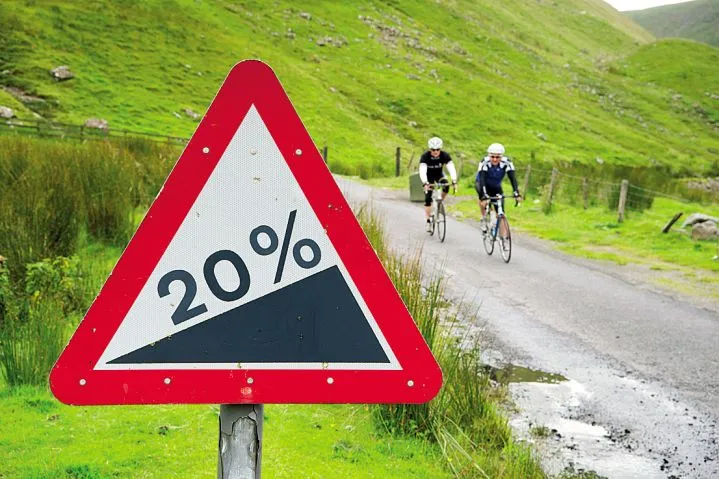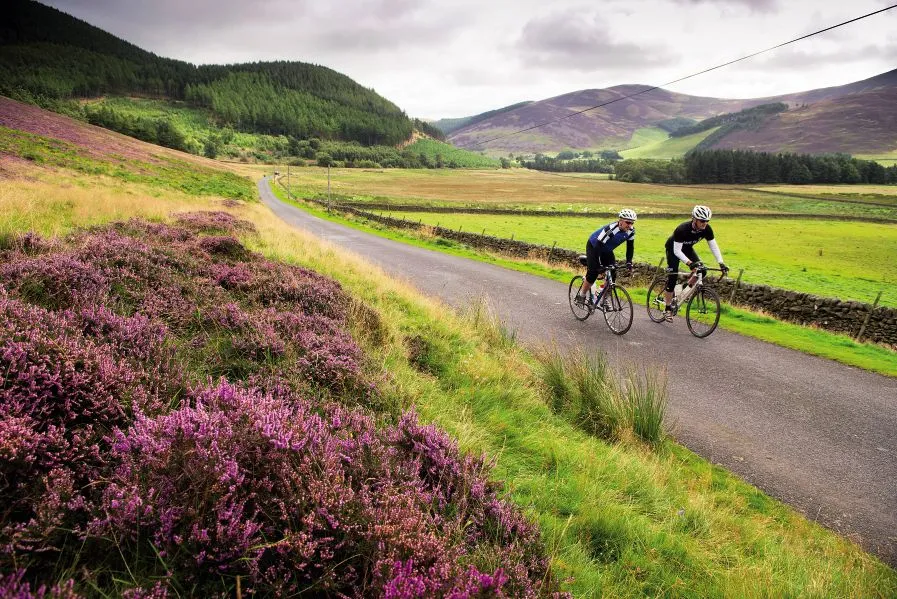Ride information
- Distance 55.2 miles (88.9km)
- Climbing 1432m (4698ft)
- Grade Medium Duration 2.5-3 hours
- Maps OS Landranger 73 Peebles, Galashiels & Selkirk, 72 Upper Clyde Valley
- Download the route www.cyclescottishborders.com/route/megget-talla
One of the great beauties of riding in the Scottish Borders isn’t necessarily the spectacular landscape – although it truly is beautiful – or the wonderfully quiet roads, but the history of this great area. Turn any corner and you are presented with a ruined castle, ancient drove road or evidence of the turbulent times it has seen as a borderland. Our start from Innerleithen was no different as we quickly came up to the village of Traquair.
I could regale you with some fairly standard history about Traquair House – the fact that it has been around since at least 1107 as a hunting lodge for the royalty of Scotland, or that it housed Mary Queen of Scots and various Jacobites during the rebellion – or I could cut to the chase and tell you that they brew some pretty fantastic ale here, one of which would slide nicely into my hand at the end of the ride later that night.
Of course, that was only a daydream, a carrot to be dangled for finishing what was shaping up to be a tough route, some of it through some particularly rolling hills.
Up the creak
Ten minutes out of Traquair and our breathing – I was riding with my regular cycling partners Derek and Pete – had collectively deepened and idle chatter had faded to the sound of my cranks intermittently creaking out a rhythm. I really must get that lubricated, I thought, as we pushed on. Derek pulled to the front, occasionally pointing out pretty farmhouses off to the other side of the glen, but more often than not just keeping his head down and pushing cranks. A headwind was present but nothing too drastic, though that didn’t stop the occasional complaint issuing from whoever took a turn at the front.
Green hills and glens soared off to our right as the climb continued up the east side of the glen, small burns dropping into our glen at regular intervals, fed in by sharp tributary ones. It all made for some spectacular scenery as the sun shone, highlighting the contours and giving a dancing sparkle to the river below.

Finally cresting the hilltop on the slopes of the exotically named Mountbenger Law – sounding more like a US legal TV drama series than a Borders hill – we zipped up shirts and got into the drops for a careering downhill, using both sides of the double track road when visibility allowed. The narrow glen provided a superb backdrop, but on one occasion Pete and I let our gaze wander from the road a little too long and returned it just in time to see two sheep roam listlessly onto the tarmac 30 yards ahead. Cue some sharp intakes of breath and evasive manoeuvres to keep wheel from wool.
White horses were rearing up off a steely grey loch as we battled along past St Mary’s kirkyard high on the hill and on to where a grand old-fashioned AA call box signalled our turnoff to continue the westerly leg of our circuit. Had we carried on along the main road we would shortly have come to the excellent Glen Cafe – a well-known stopping point for travellers and day-trippers to the loch – and the legendary Tibbie Shiels Inn. Originally established in 1824 or so, the original Tibbie Shiels, recently widowed with a young family to support, started to take in lodgers to make ends meet. Of course, Tibbie has long gone, but the inn remains a cracking spot for a swift ale if you’re exploring the nearby hills, and is a good detour off this route if you fancy a spot of the good stuff on your ride.
Not for us, though – what with the headwind and time moving on, we decided to keep our heads down. After some undulating miles, the road eventually made its mind up and kicked hard up to the shores of the Megget Reservoir above. A modern road made for some lovely riding once we hit the waterside – if it wasn’t for that ever-present wind, of course – where the surface was silky smooth in sections and the gradient levelled out for a change.
Feeding secondary reservoirs positioned above Edinburgh, the water’s final destination, the Megget is the largest earth-dammed reservoir in Scotland and situated in among some imposing hills it was a pretty impressive sight. It was odd riding along a wide, smooth road with virtually no one on it, but most welcome as we took time to chat and enjoy the view over sparkling waves.
Borders collie
If we had thought the climbing was over, though, we were wrong. At the far end of the water the road narrowed and began to heave skyward yet again. We pushed on, pausing for a soft pedal when a flock of sheep was herded up the road in front of us by a farmer astride a quad bike. A lazy wave over his shoulder gave thanks for our waiting as he fed them through a side gate and onto the hill, and was the signal for us to get our heads down again into that ever-present breeze. A collie sitting patiently on the back of the quad eyed us warily, clearly wondering what the hell we were doing out on the open moor without a motor.
At the summit we paused for a while to absorb the view, pausing again when the road crested the last edge before the descent to Talla Reservoir. The landscape was truly spectacular, dropping away to the water below in a picture postcard setting of heathery hills and blue sky.
It was with a steely grip that we started the drop off to the reservoir, steep and relatively slippy as it turned out to be. Derek raced off in front as usual, with Pete and I taking a more safety-conscious speed. Once speed was gained it was pretty hard to shave it off, and with sheep populating the sides of the road, ready to spring on unwary travellers, caution was undoubtedly the best bet. A final treacherous corner with a sheet of water running across the apex made a fitting end to it, and we could finally release our grip on the drops.

A beautiful, gradual descent began after a lovely level pedal around the edge of the Talla Reservoir, dropping down through the trees and the occasional house until popping us out onto the main A701. This was where all our hard work began to pay off. The wind had finally swung around behind us, and all that height credit we had been stacking up was really starting to pay dividends – not in a brutal way, like the descent to Talla, but more gradually as we shadowed the Tweed’s infant steps toward the sea.
We sustained upwards of 30mph for the whole valley, taking turns to push through the corners, using the hugely reduced wind resistance to keep the cadence high. Beside us, the trail of the dismantled railway, built to service the dam construction, was clear to see, with the odd bridge and cutting still evident. Considering it was only active between 1897 and 1910 it is amazing that it is still so visible, though the viaduct that once carried the railway over the main road now carries the water pipe for Edinburgh.
With a sigh and a winding down of the legs, we forked off the main road and reverted to the small country roads at Rachan Mill. The route re-established the usual undulations as it passed through Drumelzier, and we nearly overshot a sign for a coffee shop in the Dawyck Botanic Garden. A screech of brakes, then several lattes and stomach-filling cakes later, we tottered out and groaned back onto saddles to continue the ride, well refuelled for the last stages.
Muddy hell!
If Derek had realised what the next section held he probably wouldn't have brought his good Colnago for the trip. Dropping down to the small group of houses at Lyne Station, our GPS – programmed with the recommended route – suddenly swung its direction arrow up a narrow and mud-strewn side road, well signposted as a dead end. Who were we to argue with the electronic master? With a frown, we obeyed, and climbed quickly up to a small footbridge. The approach to the bridge was narrow dirt singletrack, which instantly had Derek cursing, and after we’d wheeled the bikes across the Tweed it didn’t get much better.
We have noticed a tendency for Borders tourist routes to get a bit off-road on occasion, so Pete and I had opted for our cyclocross bikes just in case, but this was pretty off-road by even their standards. The muddy path climbed for a hundred metres after the bridge, eventually joining another muddy farm road and salvation.

If you choose not to take that route, then it’s easy to pop out onto the A72 and hightail it into Peebles that way. It has to be said, though, once the mud had finished pinging off our down-tubes and everything had resorted to clean tarmac, it really was a pleasant backroad that we skirted along, and to miss the glen at Cademuir would have been a crime. Purple heather was blooming on both sides of the road, horses were grazing in emerald green fields and, as usual, we pretty much had the road to ourselves. Worth a bit of mud? We think so.
The drop down into the bustle of a busy Peebles Saturday was almost a shock after three hours of quiet backroads, but a welcome one with a good atmosphere glowing from all the sunny-day-trippers on the river banks. We cranked on through the town’s side roads, through leafy suburbs and out once again into the Borders countryside.
Derek put the pedal down, no doubt fuelled by the promise of a cordon bleu meal and Traquair Ale at our guesthouse, and we shot along, chain-ganging through the new golf resort of Cardrona, past Glentress mountain biking centre on the other side of the glen, and finally back into the quiet village of Traquair. A swift left turn and then we freewheeled back to our start point, crossing our constant companion of the descent, the River Tweed, for the last time.
Now, someone mentioned a Traquair House Ale?
Local knowledge
Nearest station
Edinburgh or Carstairs www.nationalrail.co.uk
Food and drink
Few places en route, but plenty of cafes in Peebles and Innerleithen. The Peel Centre in Glentress has a good selection, and we stopped at the Dawyck Botanic Garden’s café, or break off the main route for a few km at the halfway point of St Mary’s Loch for the excellent Glen Cafe.
Where to stay
We stayed in Caddon View Guest House: out of this world food and top-notch accommodation.
Bike shops
BSpoke in Peebles; and Alpine Bikes at Glentress.
Words and Images: Andy McCandlish
Subscribe to Cycling Plus
Cycling Plus has been seeking out Britain's Best Rides since 1992 – subscribe here!
